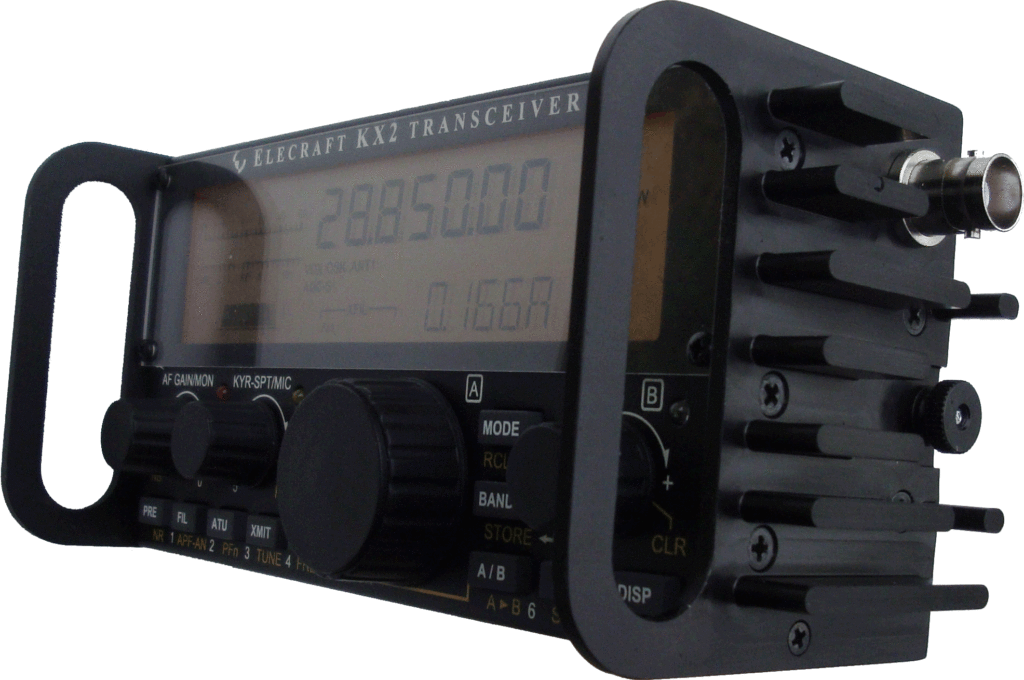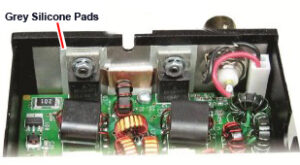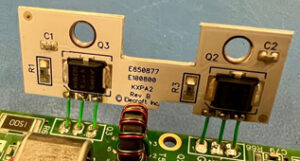Kx22 Heatsink for the Elecraft™ KX2 (click for new window)
Kx22 Heatsink for the Older Elecraft KX2
(pre-s/n 5441 with individual PA-FETs)
P/N: Kx22 Heatsink Price: $79.90
Shipping Status: In stock, immediate
Kx22b Heatsink for the Newer Elecraft KX2
(post-s/n 5441 with SMD PA-FET board)
P/N: Kx22b Heatsink Price: $79.90
Shipping Status: In stock, immediate
Pre-Mounted BNC on either your Kx22 or Kx22b
P/N: Pre-mounted BNC Price: $14.90
Shipping Status: In stock, immediate

SideKX Left side plate matching the Kx22 Heatsink
P/N: KX2 Left SideKX Plate Price: $26.90
Shipping Status: In stock, immediate

SideKX Cover for the Kx22+SideKX Left plate
P/N: KX2 SideKX Cover Price: $29.90
Shipping Status: In stock, immediate
In response to many requests from our customers, we are proud to announce the release of the Kx22 heatsink for the Elecraft™ KX2! As we did with the Kx31 and Kx32 heatsinks for the Elecraft™ KX3, the Kx22 is designed using thermal modeling and offers the maximum cooling by natural convection. Given the extreme portability designed into the KX2, our main goal was to maintain the small size and light weight of the KX2 while offering improved thermal performance in transmit, and we believe we succeeded on all fronts. The width of the petite KX22 heatsink is only 0.4″ (10 mm), which is less than the KX2’s BNC jack protrudes so it still fits in the LowePro bags offered by Elecraft. The weight is only 1.36 oz (38.7 g) so there is little weight penalty when packing the rig for a hike.
The Kx22 is a billet-aluminum piece black-anodized to match and compliment the appearance of the rig. It offers the extended transmit time desired by KX2 digital mode operators of up to 250% at full output.
If you already have the GEMS KX2 SideKX, then you need only order the Kx22 which replaces the right-end SideKX plate. If you want to forego relocating the BNC connector from the stock plate to the Kx22, you can order a Pre-mounted BNC. If your KX2 has the stock end panels, then order both the Kx22 Heatsink and Left SideKX Plate. In either case you would benefit by also purchasing the matching SideKX KX2 cover to provide dust and splash protection. With the cover installed, it is like putting the KX2 in a hard case but much more compact and light, and all controls are protected from damage. The Kx22 Heatsink is also 100% compatible with the GEMS KX2 Mobile Mount.
- Designed using thermal modeling software for best performance.
- Ratio of base mass to fin area optimized for the duty cycle of digital modes.
- Rounded cross-section for no-snag use in fabric cases, and no sharp corners to cut or damage adjacent objects.
- When mounted on Elecraft™ KX2 along with GemsProducts™ SideKX plates and cover, the combo will fit in a standard LowePro CS40 or CS60 case.
- Custom-color black anodized instead of powder-coated for superior thermal performance.
- Radiusing compliments the design of the GemsProducts™ SideKX.
- Custom fin spacing matches KX2 screw placement for a clean appearance, it does not look like a stock heatsink profile modified to fit.
- Optimum compromise for most all operators between stock appearance and enhanced transmit time.
- The Kx22 is supplied with an installation manual, correct hardware and a packet of heat-transfer grease.
- Each heatsink is visually checked after machining, and again after anodizing to make sure there are no defects before being shipped to you.
Size: width – 2.86” (72.6 mm)
depth – 0.5” (12.7 mm)
height – 2.57” (65.3 mm)
Weight: 1.36 oz., 38.7 g.
Color: Custom dye batch black to match the Elecraft™ KX2
Thermal Resistance: <6°C/W
Surface Area: 15.3 inches^2 (3420 mm^2)
Warranty: The Kx22 is warrantied against all manufacturing defects. Read all Warranty details here.
Key-down Transmit Time Improvement:
80M-250%, 40M-250%, 20M-250%, 15M-250%, 10M-200%
In order to validate the design, we ran a complete set of stock and modified performance tests. The test was conducted with a air tunnel around the KX2 to restrict the air movement to the convective flow powered by the heatsink itself. This removes room air movement as a variable, since almost undetectable amounts of movement can greatly increase the heat removed from a heatsink.
NOTE! (We know of no other test done with a shield to eliminate external air movement, which can increase the cooling by 100% or more but which is an uncontrolled variable. In most normal environments the PAE-Kx22 will allow much more transmit time than our own data supports.)
Thermal transfer compound was used between the PA FETs and heatsink. We ran the KX2 RF output into a Bird Termaline 50Ω load, and measured RF power output with a Bird 43 with a 25H element. The DC power was provided by a Xantrex HPD 30-10 supply and was monitored using an HP 3468B DVM. 3 trials were averaged on each band pre and post-heatsink mod, and the summary data of transmit time improvement is below:
80M-250%, 40M-250%, 20M-250%, 15M-250%, 10M-200%
From the results you can see that the improvement in key-down time is as much as 250% depending on band. Our goals were to be able to run 10W in digital modes for extended periods on all bands without power fold-back, and to do as little harm as possible to the excellent appearance of the KX2. This heatsink achieves both goals without any fans and without being excessively large.
1) I don’t want to disassemble the tiny antenna connector to install the Kx22.
The small size of the KX2’s internal antenna connector can be challenging, especially for those of us with older eyes. Fortunately it is really not that difficult if you use a small jeweler’s flat-bladed screwdriver to depress the locking tang. Full instructions are in the manual which is available for download by clicking the ‘Downloads’ tab above. If you still do not want to perform this part of the install you can purchase the Pre-mounted BNC option, and your Kx22 will come ready to mount and go.
2) Why aren’t more fins better?
On the surface if it, this would seem to make sense, the more fins, the more area for heat to be conducted from the base of the heatsink. So it stands to reason if more fins are better, carried to it’s extreme a solid block conducts heat from it’s base the best of all, which is true! The problem with a solid block is it has little surface area for the surrounding air to touch and remove that heat, so we accept the need to have fins to increase surface area.
Although we are normalized to moving through it every day without noticing it, air is a viscous substance. The standard unit of viscosity is the centipoise, and water at 68.4°F (20.2°C) has a viscosity of 1.0 centipoise. Air at this temperature has a viscosity of 0.01983 centipoise, or roughly 2% that of water. It sticks to surfaces as well as water does, so air flowing between fins is similar to water flowing through a pipe. The smaller the space it is flowing through, the higher the resistance to flow. This is because the air molecules touching the surface of the heatsink are stationary on it, they are literally attached. They also strongly interact with the air molecules next to them. It takes work to pull the molecules apart, a function called viscous shear. This work is the resistance to air flow. The other main factor determining the optimum amount of fins is fin height. The deeper the channel the air is flowing through, the more difficult it is for the viscous air to move to the base of the fins, and the result is a diminishing advantage to additional height at some point as the air stagnates at the fin’s base.
In a heatsink designed for natural convection (no fan) the force moving the air is merely the difference in density between the air heated by contact with the heatsink fins and the cooler air below it. The heated air rises, pulling cooler air into place behind it. Heatsinks designed for use with fans can employ closer and longer fins, because there is a fan opposing the viscosity and forcing the air, but these heatsinks, like CPU and GPU heatsinks make poor natural convection heatsinks. Some claim they work well, but any legitimate testing would show otherwise.
The equation for optimum spacing and height of fins ends up settling out with ~2:1 fin height to space ratio being optimum. With the Kx22, the side panel has six screws, the back panel thumbscrew with it’s needed clearance and the BNC jack, all which limit the length and number of fins.



